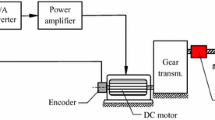Abstract
This work analyzes the available methods of backlash compensation in servo systems of electric drives with position/contour profile control of working bodies of technological machines. Their main advantages and disadvantages in controlling single-channel electric drives are revealed. These advantages and disadvantages make the systems in question insufficiently efficient when used in the machine-tool construction, metalworking, and in-line equipment for the chemical, textile, and other industries. The typical astatic servo system of an electric drive with cascade current, voltage, and position control is analyzed in detail by correctly applying the harmonic linearization (describing function) method. The reasons for the occurrence of self-oscillations and deterioration in the quality of transient processes of an electric drive with backlash in its mechanical part are revealed. Complementary methods of compensating the influence of backlash by adjusting the properties of the integrating elements in the main position control loop in the case of abrupt changes in kinematics are developed as a result of a frequency analysis of the behavior of the nonlinear system of the electric drive. These methods are implemented using a PI position controller with a switchable integral part and additional stabilizing feedback to the current controller input against the difference in angular displacements of the electric motor and the working body. The efficiency of the theoretical study results is confirmed by a detailed mathematical modeling of the control systems developed for electric drives, as well as by full-scale experiments on a multifunctional test bench.









Similar content being viewed by others
REFERENCES
Ivankov, V.A., Tararykin, S.V., and Krasil’nik”yants, E.V., Konturno-pozitsionnoe upravlenie reduktornymi elektroprivodami mnogotselevykh metallorezhushchikh stankov (Position/contouring Control of Reductor Drives of Multipurpose of Metal-Cutting Equipment), Ivanovo: Ivanov. Gos. Energ. Univ., 2009.
Sarantsev, S.S., Structural and parametric synthesis of electric drive with backlash nonlinearity in its kinematic chain, Cand. Sci. (Eng.) Dissertation, Samara: Samara Polytech, 2013.
Polyshchenkov, I.S., RF Patent 2655723, Byull. Izobret., 2018, no. 5.
Terekhov, V.M. and Osipov, O.I., Sistemy upravleniya elektroprivodov (Control Systems of Electric Drives), Moscow: Akademiya, 2005.
Nordin, M. and Gutman, P.O., Controlling mechanical systems with backlash—a survey, Automatica, 2002, vol. 38, no. 10, pp. 1633–1649. doi https://doi.org/10.1016/S0005-1098(02)00047-X
Tao, G. and Kokotovic, P.V., Adaptive Control of Systems with Actuator and Sensor Nonlinearities, John Wiley & Sons, 1996.
Lai, G., Liu, Z., Zhang, Y., Philip, Chen, C.L., and Xie, S., Adaptive inversion-based fuzzy compensation control of uncertain pure-feedback systems with asymmetric actuator backlash, IEEE Trans. Fuzzy Syst., 2017, vol. 25, no. 1, pp. 141–155. https://doi.org/10.1109/TFUZZ.2016.2551292
Sarangapani, J., Neural Network Control of Nonlinear Discrete-Time Systems, Control Engineering Series, Boca Raton, Fla.: CRC Press, 2006. https://doi.org/10.1201/9781420015454
Kalantari, R. and Saadat Foomani, M., Backlash nonlinearity modeling and adaptive controller design for an electromechanical power transmission system, Sci. Iran., 2009, vol. 16, no. 6, pp. 463–469.
Formentini, A.A., Oliveri, A., Marchesoni, M., and Storace, M., Switched predictive controller for an electrical powertrain system with backlash, IEEE Trans. Power Electron., 2017, vol. 32, no. 5, pp. 4036–4037. https://doi.org/10.1109/TPEL.2016.2587756
Besekerskii, V.A. and Popov, E.P., Teoriya sistem avtomaticheskogo upravleniya (Theory of Automatic Control Systems), St. Petersburg: Professiya, 2003.
Lichtsinder, A. and Gutman, P.O., Limit cycle existence condition in control systems with backlash and friction, IFAC Proc. Vol., 2010, vol. 43, no. 14, pp. 469–474. https://doi.org/10.3182/20100901-3-IT-2016.00055
Lichtsinder, A. and Gutman, P.O., Closed-form sinusoidal-input describing function for the exact backlash model, IFAC-PapersOnLine, 2016, vol. 49, no. 18, pp. 422–427. https://doi.org/10.1016/j.ifacol.2016.10.202
Turbo PMAC Clipper (Turbo PMAC2-Eth-Lite): Hardware Reference Manual, Chatsworth, Calif., Delta Tau Data Systems, 2009. http://www.industek.co.kr/wordpress/wp-content/uploads/2020/11/TURBO-PMAC-CLIPPER-HRM.pdf.
Funding
This work was written as part of state assignment no. 075-03-2021-143 from the Ministry of Science and Higher Education and of the Russian Federation.
Author information
Authors and Affiliations
Corresponding author
Additional information
Translated by S. Kuznetsov
About this article
Cite this article
Tararykin, S.V., Apolonskiy, V.V. Controlling a Servo Drive with Backlash in High-Rigidity Power Transmission. Russ. Electr. Engin. 93, 16–25 (2022). https://doi.org/10.3103/S1068371222010102
Received:
Revised:
Accepted:
Published:
Issue Date:
DOI: https://doi.org/10.3103/S1068371222010102




